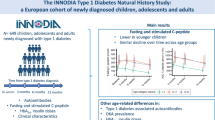Abstract
The Accelerator hypothesis postulates that Type 1 Diabetes (T1D) and Type 2 Diabetes are mostly the same disorder. Till now, the data testing the hypothesis and the importance of BMI and insulin resistance in the development of T1D comes almost exclusively from childhood. Our study aimed to investigate changes in clinical and metabolic characteristics of young adults at diagnosis of T1D during the last decade in a Mediterranean area. Ninety-three adults (≥18 years) with newly diagnosed T1D were evaluated from our database. Thirty-one of them were diagnosed in the period 07/1994–1995 (G95), 39 between 07/1998 and 1999 (G99) and 23 in 2003 (G03). Plasma C-peptide measurements were performed before and 6 min after intravenous injection of 1 mg of glucagon. In those subjects with a basal C-peptide ≥0.2 nmol/l, insulin resistance was evaluated using the HOMA-2 model. HbA1c, GAD, IA2 and insulin autoantibodies were measured. There was not a significant rise in BMI at diagnosis of T1D in young adults admitted to our Hospital. This was also the case when BMI after 4 weeks of diagnosis was considered (23.7 ± 3.6, 23,6 ± 2.4 and 23.4 ± 3.3 kg/m2, G95 G99 and G03, respectively). In the entire group of subjects, we could not observed any relationship between the patients BMI and age at diagnosis. Likewise, we could not observed differences in any of the clinical, immunological or metabolic characteristics. IR was not different between groups (G95 n = 18, 0.73 ± 0.21; G99 n = 29, 0.86 ± 0.33; G3 n = 13, 0.66 ± 0.34) and was not related to the age at diagnosis. In summary, our data collected from young adults with newly diagnosed T1D from a Mediterranean area indicates that the phenotype, including BMI, at the onset of the disease has not substantially varied during the last decade. In spite of our data do not fit with the accelerator hypothesis the postulate could be of interest in a different age group.
Similar content being viewed by others
References
Wilkin TJ (2001) The accelerator hypothesis: weight gain as the missing link between Type I and Type II diabetes. Diabetologia 44:914–922
Dabelea D, D’Agostino RB Jr, Mayer-Davis EJ, Pettitt DJ, Imperatore G, Dolan LM, Pihoker C, Hillier TA, Marcovina SM, Linder B, Ruggiero AM, Hamman RF (2006) Testing the accelerator hypothesis: body size, beta-cell function, and age at onset of type 1 (autoimmune) diabetes. Diabetes Care 29:290–294
Knerr I, Wolf J, Reinehr T, Stachow R, Grabert M, Schober E, Rascher W, Holl RW (2005) The ‘accelerator hypothesis’: relationship between weight, height, body mass index and age at diagnosis in a large cohort of 9,248 German and Austrian children with type 1 diabetes mellitus. Diabetologia 48:2501–2504
Kibirige M, Metcalf B, Renuka R, Wilkin TJ (2003) Testing the accelerator hypothesis: the relationship between body mass and age at diagnosis of type 1 diabetes. Diabetes Care 26:2865–2870
Libman IM, Pietropaolo M, Arslanian SA, LaPorte RE, Becker DJ (2003) Changing prevalence of overweight children and adolescents at onset of insulin-treated diabetes. Diabetes Care 26:2871–2875
Betts P, Mulligan J, Ward P, Smith B, Wilkin T (2005) Increasing body weight predicts the earlier onset of insulin-dependant diabetes in childhood: testing the ‘accelerator hypothesis’ (2). Diabet Med 22:144–151
Pundziute-Lycka A, Persson LA, Cedermark G, Jansson-Roth A, Nilsson U, Westin V, Dahlquist G (2004) Diet, growth, and the risk for type 1 diabetes in childhood: a matched case-referent study. Diabetes Care 27:2784–2789
Porter JR, Barrett TG (2004) Braking the accelerator hypothesis? Diabetologia 47:352–353
Vidal J, Fernandez-Balsells M, Sesmilo G, Aguilera E, Casamitjana R, Gomis R, Conget I (2000) Effects of nicotinamide and intravenous insulin therapy in newly diagnosed type 1 diabetes. Diabetes Care 23:360–364
Knerr I, Wolf J, Reinehr T, Stachow R, Grabert M, Schober E, Rascher W, Holl RW (2005) The ‘accelerator hypothesis’: relationship between weight, height, body mass index and age at diagnosis in a large cohort of 9,248 German and Austrian children with type 1 diabetes mellitus. Diabetologia 48:2501–2504
Palmer JP, Fleming GA, Greenbaum CJ, Herold KC, Jansa LD, Kolb H, Lachin JM, Polonsky KS, Pozzilli P, Skyler JS, Steffes MW (2004) C-peptide is the appropriate outcome measure for type 1 diabetes clinical trials to preserve beta-cell function: report of an ADA workshop, 21–22 October 2001. Diabetes 53:250–264
Dabelea D, D’Agostino RB Jr, Mayer-Davis EJ, Pettitt DJ, Imperatore G, Dolan LM, Pihoker C, Hillier TA, Marcovina SM, Linder B, Ruggiero AM, Hamman RF (2006) Testing the accelerator hypothesis: body size, beta-cell function, and age at onset of type 1 (autoimmune) diabetes. Diabetes Care 29:290–294
Kyvik KO, Nystrom L, Gorus F, Songini M, Oestman J, Castell C, Green A, Guyrus E, Ionescu-Tirgoviste C, McKinney PA, Michalkova D, Ostrauskas R, Raymond NT (2004) The epidemiology of Type 1 diabetes mellitus is not the same in young adults as in children. Diabetologia 47:377–384
Aguilera E, Casamitjana R, Ercilla G, Oriola J, Nicoletti F, Gomis R, Conget I (2005) Clinical characteristics, beta-cell function, HLA class II and mutations in MODY genes in non-paediatric subjects with Type 1 diabetes without pancreatic autoantibodies. Diabet Med 22:137–143
Aguilera E, Casamitjana R, Ercilla G, Oriola J, Gomis R, Conget I (2004) Adult-onset atypical (type 1) diabetes: additional insights and differences with type 1A diabetes in a European Mediterranean population. Diabetes Care 27:1108–1114
Author information
Authors and Affiliations
Corresponding author
Rights and permissions
About this article
Cite this article
Giménez, M., Nicolau, J., Vidal, J. et al. Phenotype changes at the onset of type 1 diabetes in young adults from a Mediterranean area throughout the last decade. Acta Diabetol 45, 87–90 (2008). https://doi.org/10.1007/s00592-008-0028-9
Received:
Accepted:
Published:
Issue Date:
DOI: https://doi.org/10.1007/s00592-008-0028-9




